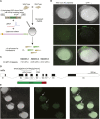Genetic manipulation of betta fish
- PMID: 37545763
- PMCID: PMC10401044
- DOI: 10.3389/fgeed.2023.1167093
Genetic manipulation of betta fish
Abstract
Betta splendens, also known as Siamese fighting fish or "betta," is a freshwater fish species renowned for its astonishing morphological diversity and extreme aggressive behavior. Despite recent advances in our understanding of the genetics and neurobiology of betta, the lack of tools to manipulate their genome has hindered progress at functional and mechanistic levels. In this study, we outline the use of three genetic manipulation technologies, which we have optimized for use in betta: CRISPR/Cas9-mediated knockout, CRISPR/Cas9-mediated knockin, and Tol2-mediated transgenesis. We knocked out three genes: alkal2l, bco1l, and mitfa, and analyzed their effects on viability and pigmentation. Furthermore, we knocked in a fluorescent protein into the mitfa locus, a proof-of-principle experiment of this powerful technology in betta. Finally, we used Tol2-mediated transgenesis to create fish with ubiquitous expression of GFP, and then developed a bicistronic plasmid with heart-specific expression of a red fluorescent protein to serve as a visible marker of successful transgenesis. Our work highlights the potential for the genetic manipulation of betta, providing valuable resources for the effective use of genetic tools in this animal model.
Keywords: CRISPR; Tol2 system; betta fish; genetic manipulation; genome editing; knock in; knock out; transgenesis methodologies.
Copyright © 2023 Palmiotti, Lichak, Shih, Kwon and Bendesky.
Conflict of interest statement
The authors declare that the research was conducted in the absence of any commercial or financial relationships that could be construed as a potential conflict of interest.
Figures



Update of
-
Genetic manipulation of betta fish.bioRxiv [Preprint]. 2023 Feb 16:2023.02.16.528733. doi: 10.1101/2023.02.16.528733. bioRxiv. 2023. Update in: Front Genome Ed. 2023 Jul 21;5:1167093. doi: 10.3389/fgeed.2023.1167093. PMID: 36824853 Free PMC article. Updated. Preprint.
References
Grants and funding
LinkOut - more resources
Full Text Sources

